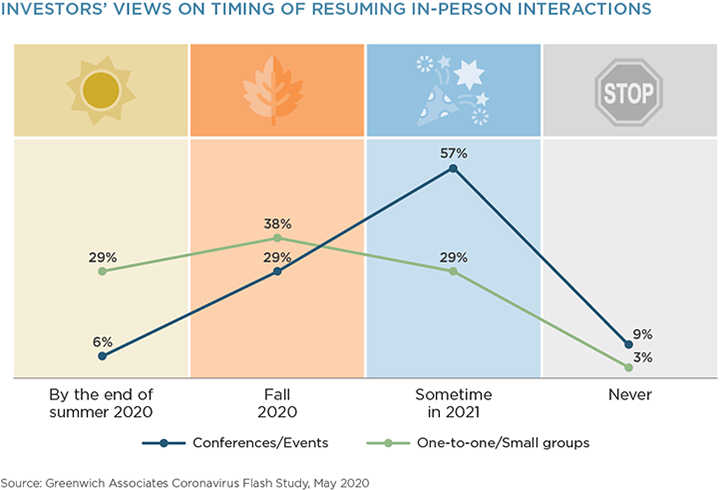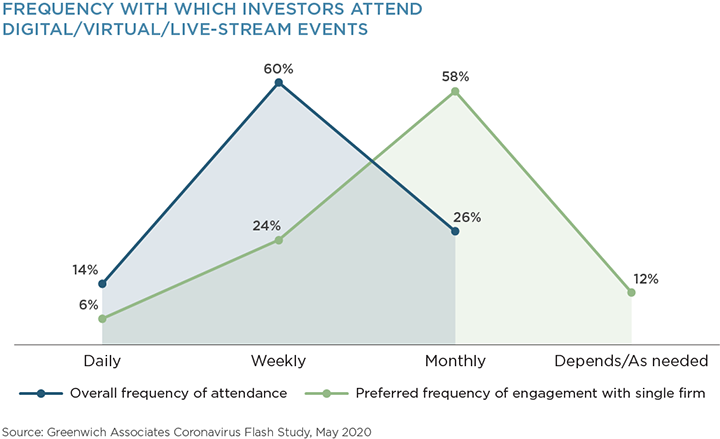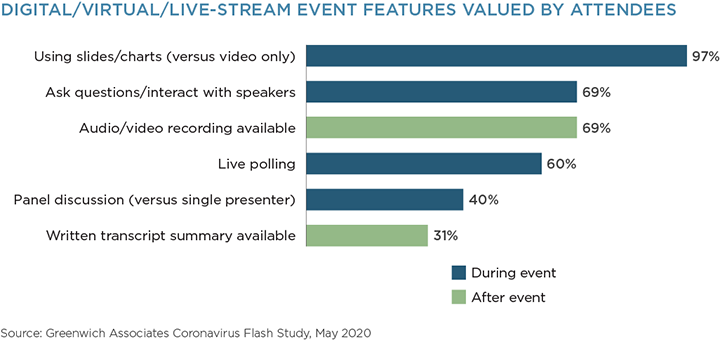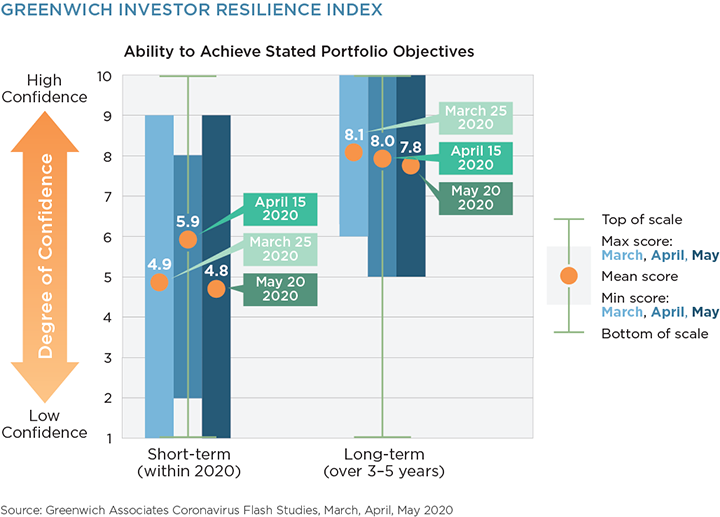
Table of Contents
No matter how comfortable you felt in a virtual environment prior to the current crisis, by now you are likely much more confident in your own digital fluency, the strength of your firm’s digital infrastructure and the value that can be extracted from digital-only interactions.
Institutional investors have been registering for more webinars than a single person can possibly attend—hopeful, of course, that they will find a way to fit each one into the schedule but knowing, in the end, that it will come down to a review of the recording or transcript for most of these events.
For those of you on the “host” side of this equation, you are probably wondering…
- Have we hit the webinar saturation point?
- What is the optimal cadence for digital engagement opportunities with our clients?
- If we are going to host an event, which features do audience members truly value?
- And—perhaps at the top of your list—when will we be able to return to in-person interactions?
Is There a Light at the End of the Virtual Tunnel?
Before diving into the do’s and don’ts of hosting a virtual event, let’s examine some data showing how long institutional clients and prospects think we will be operating within this “new normal” interaction framework. In Part 7 of the Pandemic Perspectives series, about 55% of asset managers told us they would expect to resume in-person interactions with clients by the end of the summer, with another 40% expecting to hit that mark by October 1st.
Managers might be embracing an overly optimistic outlook, as only 29% of institutional investors expect to resume one-to-one or small group meetings by the end of the summer. Another 38% believe we will reach that point by the fall, but about 30% think we are looking at 2021 as the benchmark (compared to just 5% of asset managers).

Investors’ perspectives are even more conservative related to larger group, in-person events. Only 35% of institutional investors believe that conferences and the like will be feasible before the end of the year. More than half (57%) expect to resume these activities in 2021—and close to 10% surmise that large group events and conferences might be a relic of the past.
It looks like asset managers would be smart to continue to invest resources and focus on preparing and executing top-quality virtual events, as the tunnel to the other side still appears to be quite long.
You Can Teach Old Dogs New Tricks
In the fall of 2018, we asked institutional investors about their information consumption habits and preferences. At the time, only 31% of respondents said that webinars were the most impactful medium for asset managers to share content.
Yet last week, 85% of the institutional investors we spoke with said they had attended some type of digital, virtual or live-stream event hosted by an asset manager – and on average, they rated the value 4.1 on a 5-point scale, with “5” representing “Very Valuable.” Events hosted by investment consultants seem to be equally popular—and valuable—with attendance at 83% and a value score of 4.1.

In a time when investors are seeking direct feedback and advice about their portfolios and the impact of market conditions on the products in which they are invested, events hosted by industry organizations (presumably focused on broader topics) seem to be hitting the back burner more quickly. Only 59% of investors say they have attended one of these events.
It seems, based on this flurry of digital event attendance and reported value, that the coronavirus pandemic has pushed people outside of their comfort zones—and faced with few other options, investors have begun to embrace the value of the webinar.
Where is the Tipping Point?
What began as a small wave brought on by a group of asset managers dipping their toes into the digital ocean at the start of the pandemic has turned into a tsunami of digital events. Once firms discovered that investors would be receptive to more opportunities to connect digitally, organizations that had previously hosted infrequent events began to speed up the cadence. Those that had largely avoided the webinar format in the past began to develop a digital event schedule at breakneck speed. Overnight, the menu of webinar options shifted from underwhelming to overpowering.

Over 70% of institutional investors are attending digital events at least weekly, with about 15% engaging daily. But just because your clients and prospects are willing to engage this frequently does not mean they want to engage with YOU so often. Striking the right balance of offering proactive advice and guidance while also respecting that your clients likely have meaningful relationships with 10 or more other asset managers is critical.
Investors’ current appetite supports monthly invitations to digital events from any one firm – unless, of course, there is a particular event or circumstance that warrants an interim update. Cue the collective sigh of relief from marketing departments around the world.
A Picture (and Recording) is Worth a Thousand Words
Convincing your clients and prospects to register for an event has (perhaps) become easier during the coronavirus pandemic, but delivering a valuable event is just as much a challenge as before. Much to the chagrin of your featured speakers, 97% of institutional investors want to see slides or charts alongside the speaker video. Nearly 70% appreciate the opportunity to interact with speakers via live Q&A or other chat methods, and 60% find value in live polling activities.

Once the digital event is over, about 70% of attendees would value an audio and/or video recording of the presentation, compared with only 31% seeking out written summaries or transcripts. In addition to providing value for those who attend and do not want to take notes or wish to share with colleagues, the recording also helps those who tend to oversubscribe and will ultimately need to listen to some events during off-hours, once the volume of required daytime work subsides.
Is Pandemic Uncertainty Wearing Down Investors’ Resilience?
While the information shared during daily news cycles seems to be generally more positive than when we started the Pandemic Perspectives series, institutional investors are becoming marginally less confident about achieving their portfolio objectives—both within 2020 and, for the first time in our series, over the longer-term as well.

The short-term Greenwich Investor Resilience Index score has dropped to 4.8 in May, relative to 5.9 in April, with the range of scores widening once again to the level we saw back in March. Long-term confidence, while still generally strong, has also dipped to 7.8—below the 8+ scores we saw in prior months.
Conclusion – Managers, Your Guidance is Valued More Than Ever
Investors value these digital experiences but are now inundated with invitations. Managers must provide engaging, interactive experiences and prepare useful supporting materials—including slides for the live presentations and recordings of each session for independent viewing.
Your clients’ and prospects’ confidence in the success of their portfolios is under pressure. Asset managers’ unwavering support of institutional investors’ needs, attention to their concerns and commitment to their ongoing education will be the key to coming out of the crisis stronger than before and with a band of loyal followers.
Part 1 – Greenwich Investor Resilience Index
Part 2 – Lessons from the Past
Part 3 – Supporting Consultants During Coronavirus
Part 4 – Asset Manager Service Quality: Pre- and Post-COVID-19 Onset
Part 5 – Leading Through Crisis
Part 6 – Useful Content in Times of Crisis

